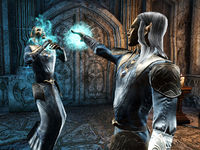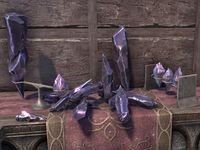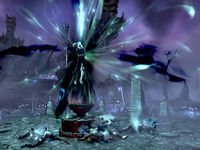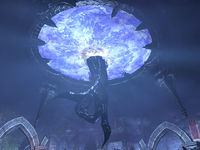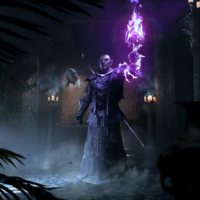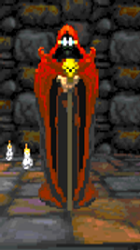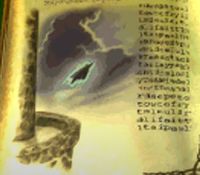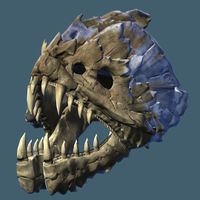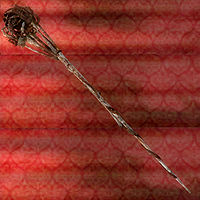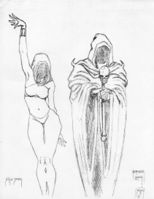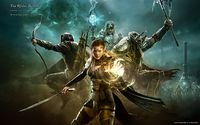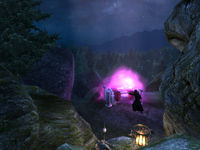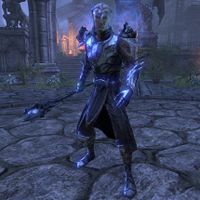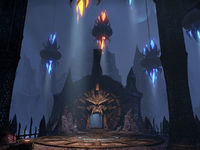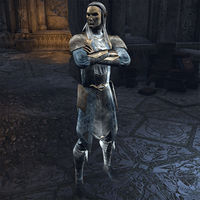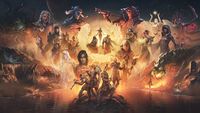Lore:Mannimarco
Contents
- "In time, the name Molag Bal will be forgotten! In time, all of Tamriel will bow down before me! Soon, the God of Schemes will have a new name: Mannimarco!"
| Mannimarco | |||
|---|---|---|---|
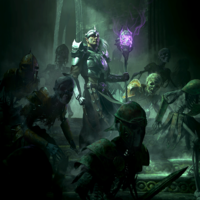 Mannimarco as he appeared in 2E 582
Mannimarco as he appeared in 2E 582 |
|||
| Race | Aldmer/Altmer† | Gender | Male |
| Final Death | 3E 433 Cyrodiil |
||
| Resided in | Artaeum Tamriel Coldharbour |
||
| Appears in | Daggerfall, Oblivion, ESO, Legends | ||
Mannimarco is the God of Worms, the founder and being of worship of the Order of the Black Worm.[1] Before his apotheosis he was an Altmer[2] (Aldmer, by his own account)[3] lich, who acted as the head of his often renamed Worm Cult. In life and unlife, he was an enemy of the Mages Guild as well as Arkay and his faithful. Before becoming the God of Worms, he was the King of Worms (also King of the Worms or Worm King[4]).
Mannimarco's claim to being an Aldmer would make him one of the oldest beings in Tamrielic history, and his necromantic talents and ascension to godhood have caused him to have a nearly unparalleled impact on Tamriel's history. If accurate, this likely indicates he was born in the Merethic Era, and he directly claims to remember events during the First Era in his interview for Where Were You When the Dragon Broke.[5] Recorded accounts of the lich's life by others date back to at least 2E 230, at the island of Artaeum.[6] Perhaps the most notable event in his history occurred roughly 1,000 years later, when he became the God of Worms during the Warp in the West.[7] Despite his ascension, he remained directly physically active in Tamriel in some capacity until at least 3E 433, the last known death of his physical body.[8]
He has enhanced his capabilities by studying the necromatic techniques left behind in the writings of the Dragon Priests and the Ayleids, and has delved into the contents of the Crimson Book of Skulls. He has also consorted with the daedra, most notable of which was Molag Bal.[9]
What is known of Mannimarco comes from books which tell a great deal not only about him, but about the time periods and his enemy Vanus Galerion. Mannimarco experienced the Dragon Break of the Middle Dawn, where he learned "his mystery" from the Maruhkati Selectives.[5] He was studying among the Psijic Order around the year 2E 230.[6] He was said to be highly intelligent, as was his fellow student Vanus Galerion, founder of the Mages Guild.[10] Galerion had a "light and warm" heart, while Mannimarco had a "dark and cold" heart.[6] Mannimarco used necromancy and trapped souls even while studying.[6] Galerion eventually confronted Mannimarco about his use of necromancy.[11] He ignored Galerion's warning, and was exiled from Artaeum by the Order as a punishment for his dark interests. He spent the next several decades gathering followers and spreading his vile practices.[12][6][10]
Mannimarco's evil began spreading throughout Tamriel and he gathered a following of Necromancers,[6] which would come to be called the Order of the Black Worm. He is described in a poem as "world's first of the undying liches".[6] When he became a lich and if he is truly the first lich is vague and contradictory. He was anachronistically called the God of Worms by the Middle Dawn of the First Era,[5] but the book Mannimarco, King of Worms puts his ascension into a lich later on, after he met Vanus Galerion in the Second Era.[6] If the latter is true, there had been many immortal liches before him.[13] During his transformation, he lost his body and mind; he became a living, moving corpse. His blood became acid, and all manner of repulsive things happened to him, and he took on the title "King of Worms".[6]
History[edit]
Mannimarco himself states that he is not an Altmer but is instead one of the Aldmer,[3] who were the original Merethic Era proto-mer.[14] Mannimarco was quoted in the book Where Were You ... Dragon Broke, as one of the people that experienced the Middle Dawn of the First Era, a phenomenon where linear time broke and became non-linear.[5] If his biography is true, he was the first lich,[6] but another source claims he may even also have been the first necromancer.[UOL 1]
Expulsion from the Psijic Order[edit]
Mannimarco was originally a member of the Psijic Order, spending much of his youth experimenting in the Traitor's Vault on the Order's island of Artaeum.[15] The necromantic character of Mannimarco's research began to disturb his friend and fellow Psijic Vanus Galerion. After discovering an experiment Mannimarco had conducted on their own classmates, Galerion informed the Psijic Ritemaster Iachesis of his activities, resulting in Mannimarco's banishment from the Order and departure for mainland Tamriel.[16] The Psijics' failure to suppress Mannimarco effectively, merely exiling him and leaving Tamriel to fall prey to his depredations, led Galerion to split from the Order and found the Mages Guild in 2E 230.[6]
Following Mannimarco and his underling's expulsion from Artaeum, one of his followers, Vastarie, allied with him over the common goal of seeking "to trap souls as one might capture lesser Daedra". They believed their objective was to be found within Coldharbour, which Vastarie agreed to venture into herself; She would be the first to bring Black Soul Gems from Coldharbour to Tamriel. They were perfect for their ambitions, as unlike other soul gems, they were "small, capable of containing even the most willful of souls, and apparently indestructible."[17]
Vastarie attempted to replicate black soul gems, but Mannimarco's aspirations would come to conflict with her own. Mannimarco desired to use them to gain power, while Vastarie desired to build upon them for ethical reasons. Fearing Mannimarco, Vastarie fled with her husband away from his clutches. Away from the King of Worms, Vastarie developed her own creation, the Sigil Geode, which was intended to be used to communicate with the dead, but Vanus rejected it out of disgust despite her good intentions.[17] Vanus actively worked against Mannimarco and his attempts to normalize necromancy. He introduced guild strictures against the use of soul-trapping on sentient mortals. This resulted in the categorization of souls into the legal White Souls of animals and beasts, and the Black Souls of fellow mortals.[18] In time, it became impossible for standard Soul Trap spells to capture a Black Soul within a regular soul gem, instead requiring the use of the more dangerous and elusive black soul gems.[19]
Mannimarco would later write the book A World of Corpses. It indicates that he finds the question on how one may find corpses to drive him to murderous rage, and he has painfully harvested the souls of those that have asked it. Thus he wrote the book to make them remember, serving as an aggressive guide on how to obtain them. The answer he finds obvious, that corpses are everywhere in Tamriel, from every city to field, as the continent has been a host to countless atrocities and conflicts.[20]
The Planemeld[edit]
Mannimarco provided counsel to the Duke of Chorrol, Varen Aquilarios, during the Colovian Revolt of 2E 576 against Emperor Leovic of the Longhouse Emperors.[21][22] By the right of conquest, Varen became the emperor and Mannimarco served as his chief advisor.[21] Around 2E 578, Mannimarco was one of the original Five Companions, which also consisted of Lyris Titanborn, Sai Sahan, Abnur Tharn, and their leader Varen Aquilarios. Their goal was to find the Amulet of Kings to give Varen legitimacy as Emperor of Cyrodiil. After they found the amulet, Mannimarco tricked them into using it to cause an event known as the Soulburst. The Soulburst would allow for the Planemeld to initiate in 2E 582, giving Molag Bal to chance to merge Nirn into his realm of Coldharbour, which if successful, would forever place it under his control.[23] Consumed by the fires of the Soulburst, Varen Aquilarios vanished, and he was officially declared dead.[24]
Prior to the Soulburst, Mannimarco was given refuge in Markarth by Ard Caddach, during which time he and his Worm Cult operated out of the ruins of Nchuand-Zel.[25] Following Emperor Varen's disappearance, Caddach expressed his gratitude to Mannimarco for the latter's role in his downfall, as Varen had usurped the Imperial throne from his cousin Leovic. In return, he agreed to provide Mannimarco with land in the Reach for experimentation, granting him a sizeable portion of land in the hills near Markarth, accessible via a Great Lift within Nchuand-Zel. Mannimarco performed a ritual to meld this land with Coldharbour, the domain of his master, Molag Bal. However, the ritual failed; the land was sundered from Tamriel, but was not sent to Coldharbour, instead becoming lost in the Void.[26] It was this sundered land which would become the realm of Grayhaven.[27]
Following the Soulburst, Mannimarco and his cult began a flurry of political actions to gain authority. These interwoven plots had required years of preparation and, in his own words, "would make even Mephala blush".[28] The King of Worms implicated Lyris and Sai Sahan in the emperor's supposed regicide. Lyris was captured by Mannimarco, while Abnur pledged his allegiance to Mannimarco in a bid to preserve the Empire. Sai Sahan fled with the Amulet of Kings, securing the artifact within the depths of Sancre Tor, where he hid it behind a ward of Stendarr.[21] Mannimarco became the true power behind the Ruby Throne, converting Empress Regent Clivia Tharn to worshipping Molag Bal, and manipulating her into expelling the Mages Guild from the Imperial City so that his Worm Cult could operate freely.[29][30][31] Abnur, Clivia's father, grew a deep hatred for Mannimarco after the Soulburst. He was soon brought to the Castle of the Worm in Coldharbour and imprisoned there.[32]
Mannimarco then turned his attention to the destruction of the three major factions that engulfed Tamriel in the Three Banners War as they vied to take the Ruby Throne. He recruited Estre, leader of the Veiled Heritance, away from her pact with Mehrunes Dagon, so that she can destroy the Aldmeri Dominion in the name of Molag Bal.[33][34][35][36] In the territories of the Ebonheart Pact, Thallik Wormfather of the Worm Cult allied with the Boneshapers, the Rageclaws, and the Stonetalon Reachmen Clans who launched an attack on the Rift.[37] They sought to resurrect the half-giant Sinmur and an army of his kin.[38] Mannimarco was indirectly involved in the Seventh Legion's annexation of Bangkorai in Daggerfall Covenant territory, with some of his old notes being used to subjugate the spirits of Hel Shira.[39]
At the height of the Three Banners War, Molag Bal's army invaded the Imperial City. One of the reasons for the city's fall are those that pledged their loyalty to the invading forces. Legion Zero betrayed the city, as they allied with the Worm Cult[40] and ceded authority to Mannimarco. The King of Worms gave the legionaries present within the city an ultimatum: fall in line or face death. Those who refused were to be captured and executed. Divided between the Empire's loyalists and those who would become known as Legion Zero, the Imperial Legion tore itself apart from within.[41] The upper echelons of the Imperial Legion, including Empress Regent Clivia Tharn and her generals, were complicit in handing the city over to the Daedra.[42]
Circa 2E 582, Mannimarco sacrificed a mortal as part of a dark ritual to Molag Bal. Instead of his victim becoming a typical Soul Shriven, he inadvertently created the Vestige, a Hero foretold by the Elder Scrolls.[43][44] This proved to be a mistake, as when Mannimarco uncovered the Amulet of King's location and attempted to retrieve it, he would be slain by the Vestige, with whom the Five Companions had been reformed.[45] Mannimarco, however, had secretly been planning to use the Amulet of Kings to capture Molag Bal's essence and take his place as a god. Mannimarco's soul was taken by Molag Bal to Coldharbour, where he was tortured for his treachery.[46]
Alternative Fate[edit]
The Psijic Order had the means to scry secrets from fate lines beyond the bounds of Tamriel. Among these secrets were tomes that spoke of alternative timelines and realities, where certain key events transpired differently.[47] In one of these alternate realities, Mannimarco defeated Molag Bal and his other enemies during the Planemeld. Mannimarco ruled over Nirn as a Daedric Prince atop a throne of bones and souls that he embedded into the sky over the Imperial City. With his victory, the world became a giant sepulcher, and the survivors of the Psijic Order even dabbled in necromancy to survive the undead onslaught that sought to purge them. With hope lost and their leader dead, the remnants of the Psijic Order attempted to do a small-scale version of the ritual that made Artaeum vanish from Nirn, not knowing if it would work.[48]
After the Planemeld[edit]
With Mannimarco gone and the Planemeld ended, a few vestiges of his influence remained. Many of the remaining members of the Order of the Black Worm flocked to the side of the Orc, Zumog Phoom, a former student of Mannimarco and a former ranking member of the order.[49][50] They aided the Euraxians of Rimmen, but Zumog Phoom was ultimately slain.[51] Mannimarco would later escape from his imprisonment and return to Tamriel.
Sometime after Mannimarco's expulsion from Artaeum, Galerion left the Mages Guild, having previously called it "a morass" of political infighting and tortuous bureaucracy;[52] but he continued to struggle against Mannimarco and his Worm Cult. Sometime after the Planemeld was stopped,[UOL 2] Galerion led the Mages Guild in an attack on Mannimarco, which turned into a great battle. Mannimarco began to unleash powerful spells. However, he felt his depraved powers fail, and the battle was won by the Mages Guild. Approximately a thousand men total died in the battle, Galerion included, and it appeared that Mannimarco had died as well.[6]
As early as 2E 864, the King of Worms was active near Sentinel. It was he who gave the "hunting grounds" of Stros M'Kai to the Sload necromancer N'Gasta.[53]
The Warp in the West[edit]
By 3E 405, the King of Worms was searching for the Totem of Tiber Septim, an artifact designed to control the Numidium while it was powered by the Mantella, from the crypt Scourg Barrow deep in the Dragontail Mountains. His plan was to obtain the Totem so that he could command the Mantella to his side as it fell from Aetherius, before it reached Numidium's chest. Using its power, he planned to leave his mortal frame, either to ascend to Aetherius[54] or join the ranks of the gods of Oblivion.[7] To achieve this, Mannimarco embroiled himself in the court politics of the Iliac Bay. In the process, he and the other major players of the area came into contact with the Agent, a Blades operative sent there by Uriel Septim VII.[55]
With the Agent's help, Mannimarco struck a bargain with Princess Morgiah, who saw little future in Wayrest as others fought for succession. Morgiah sought to arrange a marriage with King Reman Karoodil, ruler of the Kingdom of Firsthold on Auridon. To secure the king's hand, she endeavored to give him that which he desired most—to speak again with a son who had died. Mannimarco held up his end of the bargain, and in return Morgiah promised to give him her "first", though exactly what this meant remains a mystery. Regardless, Morgiah and Reman were wed after a three-year engagement.[55]
Concurrent with these events, the king of Orsinium, Gortwog gro-Nagorm, sought dirt on High Rock's royal families.[56][57]:187 He obtained a suppressed chapter of a book, the contents of which would cause considerable embarrassment to Morgiah's mother, Queen Barenziah.[58] Gortwog planned to publish it, but Mannimarco sent his necromancers in an attempt to steal the chapter from him so that he can use it for blackmail.[58] Ultimately, a somewhat edited version of the chapter was widely circulated.[59] Gortwog at one point approached Mannimarco for a consultation on what the Mantella is.[56][57]:187 Gortwog had purchased a personal letter from Emperor Uriel Septim VII that was addressed to Queen Mynisera of Daggerfall, which revealed the secret of the Totem of Tiber Septim.[60] It is believed Gortwog had sold copies of the letter to the major powers of the Iliac Bay region, as the Orcs of Orsinium stood to gain much from the resulting conflict.[61]
Mannimarco was thought to be the Underking, though this is false. Their forces have been known to be opposed to one another,[62]:50 and the Underking competed against Mannimarco for the Totem of Tiber Septim.[63][54] Mannimarco knew of the true identity of the Underking to be that of Zurin Arctus,[64] and sought to sabotage him. The Agent was contacted by the Underking to retrieve an item stolen by the King of Worms and his necromancers, which they had cursed and given to the Blades. The Agent was able to infiltrate the Blades' hideout in Ykalon and recover the item before it could bring harm upon the group.[65]
Eventually, by reading the stars, he foresaw the return of the Mantella from its hiding place in Aetherius, and wrote to this agent promising to bring the Totem to Aetherius and out of mortal hands.[54] The Agent obtained the Totem and returned the Mantella to Nirn, but the precise details of what followed are unknown due to the Warp in the West.[66] Between the 9th and the 11th of Frostfall, 3E 417, a series of inexplicable and paradoxical events occurred throughout the Iliac Bay region. Many factions had attempted to gain possession of the Totem of Tiber Septim, resulting in a distortion of time where all of these factions simultaneously gained possession, achieving their goals to some degree. This phenomenon went on to be known as the Warp in the West, and resulted in major political changes in the region.[66][67] One of the most significant results of this event was Mannimarco's successful apotheosis, which resulted in the creation of the Necromancer's Moon or the Revenant, Mannimarco's divine body.[68][1]
The Attack on the Mages Guild[edit]
Mannimarco's Worm Cult was known to have had dealings with the Sload of Thras as far back to the time of the Planemeld.[9] The Sload revered the mortal King of Worms as a hero,[69] but it is said that Sload priests interacted with Mannimarco after his ascension into their new God of Worms.[70]
Circa 3E 433, Mannimarco returned to mortal affairs in an attempt to destroy the Mages Guild and capture the soul of its Arch-Mage for study, as he had done several times throughout history in order to learn the secrets of their magical power.[71] The Arch-Mage at the time was Hannibal Traven, who had banned the practice of necromancy from the guild sometime after his promotion circa 3E 431,[72] causing a lot of disillusioned guild mages to flock to Mannimarco's side. However, Traven tricked him, sacrificing his own soul to protect the Hero of Kvatch so that Mannimarco could be confronted and killed at his lair in Echo Cave.[8]
The death of Mannimarco's mortal body had no effect on the existence of the Necromancer's Moon. The Shade of the Revenant continued to shine down on Nirn after his death,[73] and necromancers continued to offer souls to the Revenant in order to darken soul gems well into the Fourth Era.[74]
Artifacts[edit]
Despite Mannimarco's great age, only a few artifacts have been identified by scholars as belonging to him.
Bloodworm Helm[edit]
The Bloodworm Helm is the necromantic crown of the famed lich Mannimarco, who magically constructed it out of trollbone. Although beautiful to behold, many find the artifact repulsive due to its morbid nature. The helm grants the wearer greater skill at Conjuration, as well as the ability to turn the undead, drain the essence of enemies, and summon a skeletal minion. If the wearer is undead, their attacks are also made more powerful.
Mannimarco left the helm behind when he ascended to godhood during the Warp in the West.
Necromancer's Amulet[edit]
The Necromancer's Amulet (also known as the Necromancer Amulet) is a legendary artifact created by Mannimarco. In appearance it is an exquisite amulet, often with a jade skull emblazoned upon it, or sometimes carved into the shape of a tiny skull with glowing eyes. It grants the wearer magical protection equivalent to plate armor, as well as the ability to regenerate from injury, resist mundane weapons, and absorb magicka and life force. The wearer also becomes wise beyond his years and far more capable in the School of Conjuration. This comes at a price, as the amulet can drain the wearer's strength, endurance, health and stamina. The artifact is popular among both thieves and mages. The amulet is unstable in this world, and is forever doomed to fade in and out of existence, reappearing at locations distant from that of its disappearance.
Staff of Worms[edit]
The Staff of Worms is the legendary treasured artifact of Mannimarco. It is a powerful and dreadful staff with the capability to reanimate a corpse. This animated corpse remains mute and shows only minimal intelligence, but it unswervingly follows and defends the caster. Mannimarco used the staff for many of his spells and rituals, notably tearing open Mundus during the Soulburst and battling Abnur Tharn.
Gallery[edit]
Notes[edit]
See Also[edit]
- For game-specific information, see the Daggerfall, Oblivion, Elder Scrolls Online, and Legends
 articles.
articles.
Books[edit]
- Arkay the Enemy by KW — Instructions for the faithful to foil Arkay
- The Black Arts On Trial by Hannibal Traven, Archmagister of the Mages Guild — A summary of the debate which led to the Mages Guild resolution on Necromancy
References[edit]
- ^ a b Necromancer's Moon
- ^ The Improved Emperor's Guide to Tamriel: High Rock — Flaccus Terentius, 2E 581
- ^ a b c Worm Saga — Mannimarco
- ^ Torasa Aram's dialogue in Morrowind: Tribunal
- ^ a b c d Where Were You ... Dragon Broke — Various
- ^ a b c d e f g h i j k l Mannimarco, King of Worms — Horicles
- ^ a b King of Worms ending in Daggerfall
- ^ a b Confront the King quest in Oblivion
- ^ a b The Order of the Black Worm — Evoker Brucille
- ^ a b Galerion the Mystic — Asgrim Kolsgreg
- ^ Fragment: On Artaeum — Taurce il-Anselma, 3E 400
- ^ The Improved Emperor's Guide to Tamriel: Northern Bangkorai and the Mountains — Flaccus Terentius, 2E 581
- ^ Appearances of ancient liches such as the King of Miscarcand in Oblivion
- ^ Before the Ages of Man — Aicantar of Shimerene
- ^ Esulo's dialogue in ESO: Summerset
- ^ Events of Half-Formed Understandings in ESO: Summerset
- ^ a b The Legend of Vastarie — Afwa, a Student and Friend
- ^ Guild Memo on Soul-Trapping — Vanus Galerion, Archmagister Emeritus
- ^ Souls, Black and White
- ^ A World of Corpses — Mannimarco
- ^ a b c Chronicles of the Five Companions 1 — Lyris Titanborn
- ^ Pirate Queen of the Gold Coast — Midara Salviticus, Historian, University of Gwylim
- ^ Chronicles of the Five Companions
- ^ Eulogy for Emperor Varen — Lord Abnur Tharn, Chancellor of the Elder Council
- ^ The Improved Emperor's Guide to Tamriel
- ^ Ard Caddach's dialogue during the quest The End of Eternity in ESO
- ^ Count Verandis Ravenwatch's dialogue during the quest The End of Eternity in ESO
- ^ Meet the Character - Father Egnatius — Mannimarco
- ^ Abnur Tharn's dialogue in ESO
- ^ Chronicles of the Five Companions 4 — Abnur Tharn
- ^ Anchorite's Log
- ^ Events of Castle of the Worm in ESO
- ^ Letter with Singed Edges — High Kinlady Estre
- ^ The Benefits of Alliance — Mannimarco
- ^ The Danger of Defiance — Mannimarco
- ^ Our Budding Alliance — Mannimarco
- ^ Treaty of the Three Clans
- ^ Thallik's Orders — Thallik Wormfather
- ^ On the Spirits of the Hel Shira — Pampinto Scivio
- ^ Overheard dialogue from Legion Zero soldiers in ESO: Imperial City
- ^ Zelanus Equitius' dialogue during The Imperial Standard in ESO: Imperial City
- ^ Captain Caudex's dialogue during The Imperial Standard in ESO: Imperial City
- ^ Soul Shriven in Coldharbour
- ^ Varen Aquilarios' dialogue in ESO
- ^ Events of Shadow of Sancre Tor in ESO
- ^ Mannimarco's presence in Heart's Grief during God of Schemes in ESO
- ^ Tracker of Temporal Tomes achievement description in ESO
- ^ Traitor's Vault Temporal Tome — Rullinalion
- ^ Meet the Character - Zumog Phoom — Khamira
- ^ Euraxian Necromancers — Khamira, Agent of the Speaker
- ^ Events of Cadwell the Betrayer in ESO
- ^ Origin of the Mages Guild — The Archmage Salarth
- ^ N'Gasta's dialogue in Redguard
- ^ a b c Totem, Totem, Who Gets the Totem? quest in Daggerfall
- ^ a b Morgiah's Wedding quest in Daggerfall
- ^ a b The Elder Scrolls - 10th Anniversary, originally found at Elderscrolls.com
- ^ a b The Daggerfall Chronicles — Ronald Wartow
- ^ a b Barenziah's Book quest in Daggerfall
- ^ The Real Barenziah, v 3 — Anonymous
- ^ Emperor Uriel Septim VII's stolen letter in Daggerfall
- ^ Orcish Emancipation quest in Daggerfall
- ^ Arena Player's Guide
- ^ Quest-related dialogue in Daggerfall
- ^ The King of Worms' dialogue during Soul of a Lich in Daggerfall
- ^ The Ancient Watcher quest in Daggerfall
- ^ a b The Warp in the West — Ulvius Tero
- ^ Where Were You ... Dragon Broke — Various
- ^ Lives of the Emperors — Niso
- ^ Pocket Guide to the Empire, 3rd Edition: Other Lands — Imperial Geographical Society, 3E 432
- ^ People of Morrowind — Various
- ^ Mannimarco's dialogue in Oblivion
- ^ Mages Guild Charter
- ^ Shade of the Revenant in Oblivion
- ^ Hob's Fall Cave dialogue in Skyrim
- ^ Mannimarco card in Legends
- ^ Pocket Guide to the Empire, 3rd Edition: All the Eras of Man, A Comprehensive History of our History — Imperial Geographical Society, 3E 432
Note: The following references are considered to be unofficial sources. They are included to round off this article and may not be authoritative or conclusive.
- ^ Youtube Stream of The Lore of The Elder Scrolls Online, time stamp 2:42-3:40
- ^ Lawrence Schick's Posts discussing why Vanus and Mannimarco never interact during ESO
|
||||||||||||||||||||||||||||||||||||||
